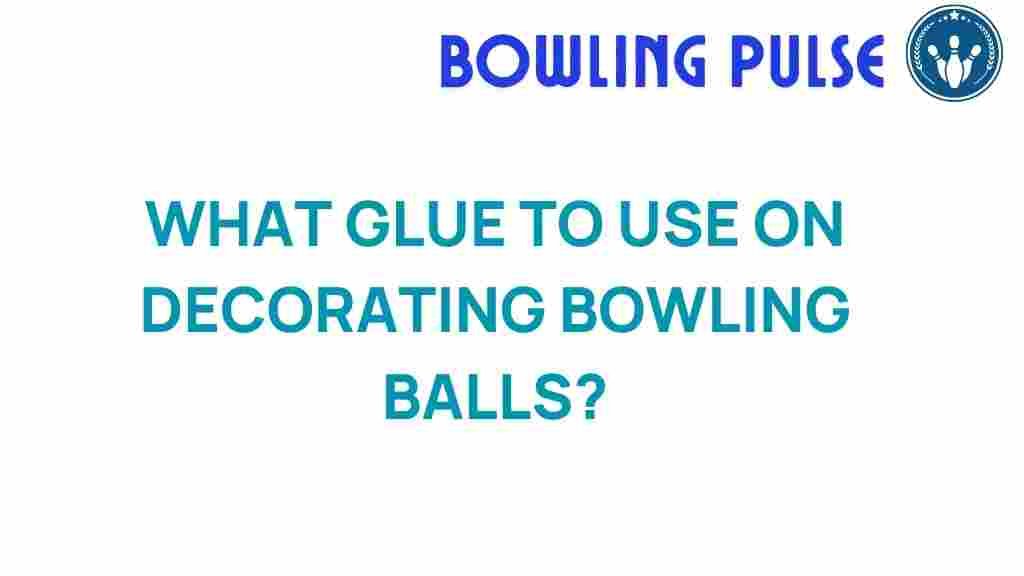The Ultimate Guide to Choosing the Right Glue for Bowling Ball Customization
Bowling is more than just a game; it’s an art form where personal expression meets athletic performance. Customizing your bowling ball can enhance not only its appearance but also its performance on the lanes. One of the essential aspects of bowling ball customization is choosing the right glue. In this guide, we will explore the various types of glues suitable for decorating and customizing bowling balls, the techniques involved, and tips for care and maintenance.
Understanding Bowling Ball Customization
Bowling ball customization involves personalizing your ball to reflect your style and improve your game. This can include adding decals, changing the grip, or even modifying the weight and balance of the ball. The glue you choose plays a critical role in ensuring that your customization lasts through many games.
Why Choose the Right Glue?
Not all glues are created equal, especially when it comes to bowling balls. The right adhesive will:
- Secure decorations and modifications without damaging the ball’s surface.
- Withstand the rigors of repeated strikes and impacts.
- Maintain the ball’s performance characteristics.
- Be easy to apply and cure quickly.
Types of Glue for Bowling Ball Customization
When it comes to customizing your bowling ball, selecting the appropriate glue is paramount. Here are some popular types of adhesives you might consider:
1. Epoxy Adhesives
Epoxy is a two-part adhesive that offers excellent bonding strength. It is ideal for heavy-duty applications, such as securing grips or repairing cracks in the ball. Epoxy is resistant to water and can handle the impact of bowling, making it a favorite among serious bowlers.
2. Super Glue (Cyanoacrylate)
Super glue is known for its quick-drying properties and strong bond. It’s perfect for smaller decorations or minor repairs. However, it may not be suitable for larger modifications due to its brittleness over time.
3. Contact Cement
Contact cement is a strong adhesive that works well for materials like rubber and plastic. It’s excellent for attaching grips or overlays. Just be cautious, as it requires precise application since it bonds instantly upon contact.
4. Hot Glue
Hot glue is a versatile option for temporary decorations or lightweight items. It’s easy to apply and remove, making it suitable for bowlers who like to frequently change their customization. However, it may not hold up under high-impact conditions.
5. Silicone Adhesive
Silicone glue is flexible and waterproof, making it ideal for decorations that may experience bending or movement. It’s also less likely to damage the bowling ball surface compared to harsher adhesives.
Techniques for Applying Glue
Once you’ve chosen the right glue for your bowling ball customization, it’s time to apply it. Here are some techniques to ensure a smooth application:
1. Prepare the Surface
Before applying any adhesive, ensure that the surface of the bowling ball is clean and dry. Use a mild detergent or rubbing alcohol to remove any dirt or oil. This step is crucial for achieving a strong bond.
2. Apply Glue Carefully
Follow the manufacturer’s instructions for the glue you are using. For epoxy, mix the two components thoroughly before application. For super glue or contact cement, apply a thin layer to both surfaces to ensure maximum adhesion.
3. Use Proper Tools
Utilize tools such as brushes, spatulas, or syringes to apply glue evenly. This will help to avoid excess glue that can create a mess or affect the ball’s performance.
4. Allow for Proper Curing
After applying the glue, allow it to cure for the time specified on the product label. Avoid using the bowling ball during this period to ensure a strong bond.
Care and Maintenance After Customization
Proper care and maintenance of your customized bowling ball will prolong its life and performance. Here are some tips:
1. Regular Cleaning
Keep your bowling ball clean by wiping it down with a soft cloth after each use. This helps remove oil and residue that can affect the adhesive and overall performance.
2. Inspect for Damage
Regularly inspect your ball for any signs of wear or damage to the decorations. Catching issues early can prevent more significant problems down the line.
3. Store Properly
When not in use, store your bowling ball in a cool, dry place, away from direct sunlight. Excessive heat or moisture can weaken adhesives and damage the ball.
Troubleshooting Common Issues
Even with the best preparations, issues may arise. Here are some common problems and solutions:
Problem: Decorations Peeling Off
Solution: If you notice that decorations are peeling, it may be due to inadequate surface preparation or low-quality glue. Remove the old adhesive carefully and reapply with a stronger adhesive, ensuring the surface is clean.
Problem: Glue Becoming Brittle
Solution: Over time, some adhesives can become brittle, especially with exposure to heat. If this occurs, consider replacing the adhesive with a more flexible option like silicone glue.
Problem: Difficulty Removing Decorations
Solution: If you want to change your customization but find it hard to remove, use a solvent appropriate for the glue used. Always test on a small area to ensure it doesn’t damage the bowling ball.
Conclusion
Customizing your bowling ball can enhance both its aesthetic appeal and performance. By choosing the right glue and applying it with care, you can ensure that your decorations stay intact through countless games. Remember to maintain your bowling ball properly and troubleshoot any issues promptly to keep your ball in top condition. For more information on bowling ball care, check out our Bowling Ball Maintenance Guide.
Whether you’re looking to express your style or improve your game, the right glue is a key component in your bowling ball customization journey. Happy bowling!
For additional resources on adhesives and their applications, visit Adhesive Technology.
This article is in the category Techniques and created by BowlingPulse Team
